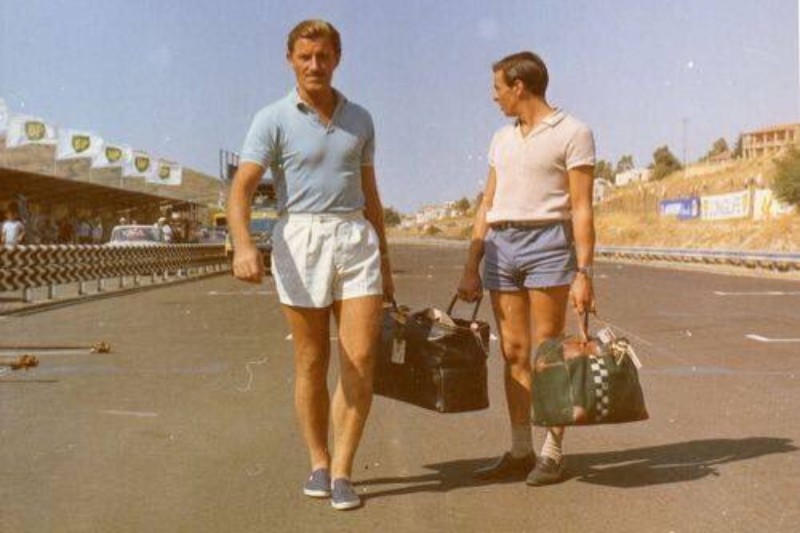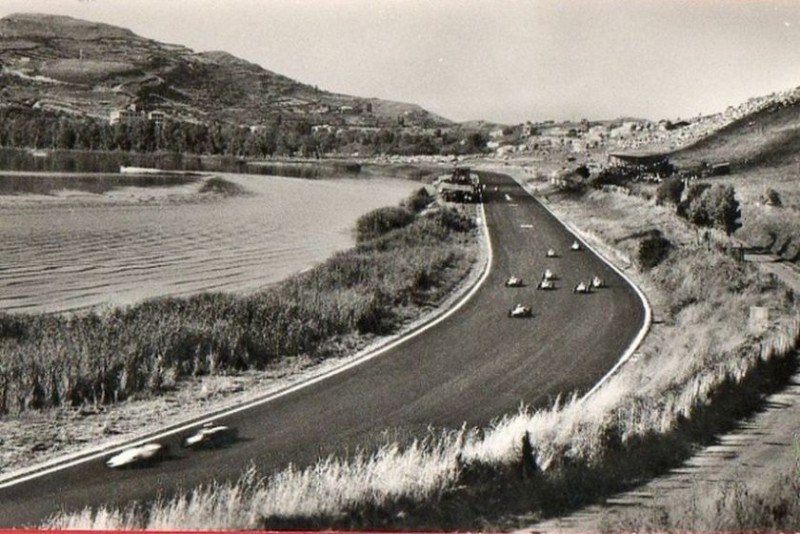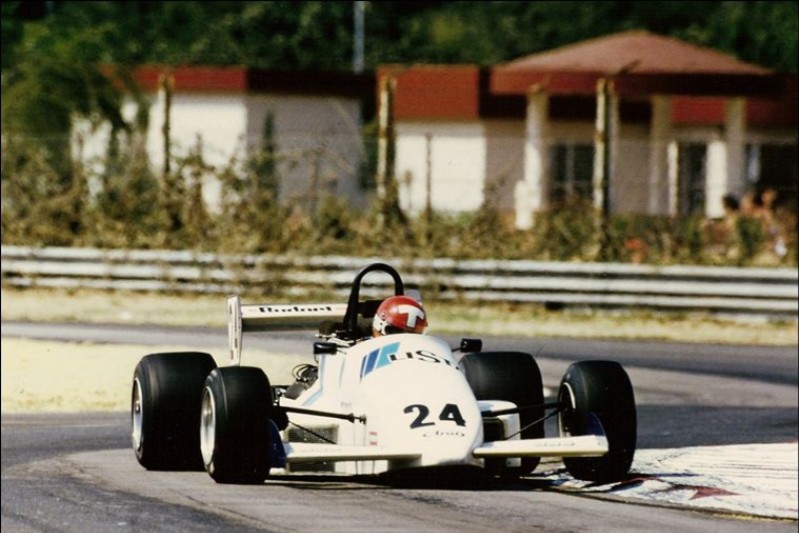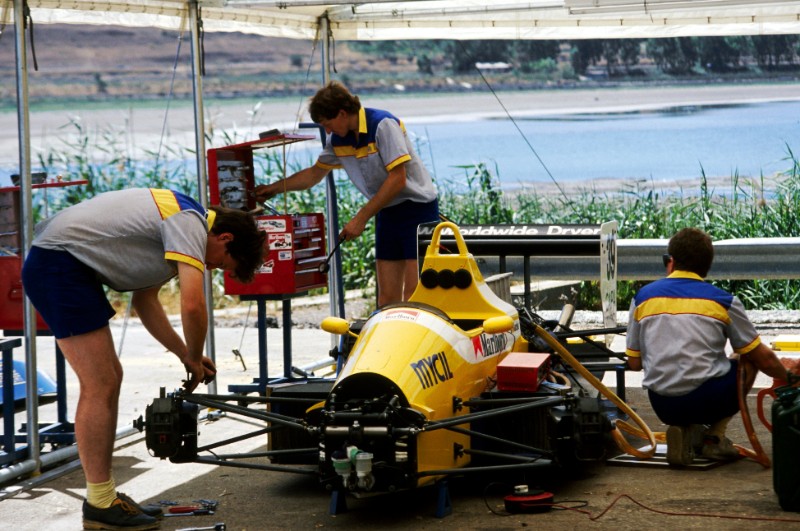
After saving the Pau Grand Prix this year, Euroformula Open’s ambition has extended to resurrecting another historic junior single-seater race for 2020 – based around a lake in a nature reserve on Italy’s volcanic island
Pictured above are Lotus team-mates Jim Clark and Graham Hill, both already Formula 1 world champions, ‘preparing’ for the 1967 Mediterranean Grand Prix. This wasn’t an event on the F1 calendar, although it had been in the past as a non-championship race, but rather a round of the inaugural European Formula 2 season.
Contested heavily by F1 drivers as it raced on different weekends, the championship established many circuits and events, none so more famous than Pau and Enna-Pergusa. Both remained on the calendar in European F2’s successor International Formula 3000 until the late 1990s, by which point F1’s primary feeder series had also becomes its primary paddock support.
Pau immediately found a home in Formula 3, while the Mediterranean GP continued with Auto GP predecessor Italian F3000 and a variety of car racing categories before the FIA revoked the Sicilian circuit’s licence in 2005.
Being based on Italy’s largest island was one of the attractions of the event in its infancy, but Enna’s high speed 4.95-kilometre layout was also extremely popular. When built around Lake Pergusa in 1951, the clockwise track had only one named corner and two defined braking zones among the full-throttle kinks. In the days of skinny tyres and no aerodynamic appendages, this was a circuit where speed really did mean bravery.
While not a street circuit, the track was in irregular use and geography of the island meant high winds would ensure there was always a layer of dust or sand on an already low grip surface. Just ask Mike Hailwood, who ended up in the lake in 1964.

The grand prix itself began in 1962, won by Ferrari’s Lorenzo Bandini, and ran to F1 rules for four years. Enna’s lap record was trounced when F2 took over in 1967, and it had an average speed of 147.49mph before a bus stop chicane was added in 1970 to slow the cars down. Only at Monza, Spa-Francorchamps and Silverstone can you watch F1 cars better those speeds today.
Proserpina chicane, named after the goddess of the underworld, was joined by Zagaria chicane in 1971 and a movement of the water-bordering pits from one side of the lake to the other. Rising speeds led to a third chicane section in the late 1970s, turning an oval-like circuit into a more Monza-esque low downforce sprint between often drama-inducing corners.
The standard of competition was rarely matched by the standard of marshalling, unsurprising given its scarce use and location, but a scary crash for Ruben Barrichello in 1992 highlighted the dangers of this. Yellow flags had not been waved while a recovery truck was in action, and Barrichello crashed into it so hard that it broke his helmet. He was miraculously unscathed, but his trip to what turned out to be a prison hospital became so because his ambulance was involved in a crash.
Winners of the grand prix during its F2 days included F1 world champions Sir Jackie Stewart, Jochen Rindt and Keke Rosberg, and when the 3.0-litre F3000 cars arrived in 1985 there continued to be some big-name successes. Future Minardi F1 driver and Hispania Racing Team team principal Luis Perez-Sala led a Pavesi Racing one-two in Ralt-Cosworths in 1986.
“In 1986 I won the Birmingham Superprix – a brilliant race – and the GP del Mediterraneo,” Perez-Sala tells Formula Scout.

1984 & ’85 winner Mike Thackwell
“It was a very successful year for me. I was fourth in the standings, and it was a nice year for me because I was in the same team with [future Minardi team-mate] Pierluigi Martini. It was fun driving together, and the Mediterranean GP was one of the most important races in F3000 in those days.
“It was quite similar to Monza, because at the beginning Enna was a round track, and then they had to put chicanes in to slow the speed a bit, but in those days it was quite normal to put chicane in [at any circuit].
“But it was not a circuit like the others because it was far away from the rest of Europe, far to go and there was not many races there. That’s why it was not a proper, proper circuit. In the winter you had no tests there, unlike the other circuits.
“The grip was lower. You didn’t have nice grip. But it was not important there because for everybody it was like that, and it was not like Birmingham which had no grip at all. Even Pau and Monte Carlo [had grip].
“If I look back, it’s one of the most important races that I won. Because it had tradition. Birmingham did not have the same tradition. Maybe in those days for me it was not the same, but now it is [very important].
“In those days, F1 was not at the same level of aerodynamics as now. That’s why the driving conditions of F3000 were quite similar. We had Lola, Ralt, Reynard as manufacturers, and some others. And engine we had Ford and Cosworth.
“We had to develop the car as well, but not like those days. It was more mechanical. We had no telemetry, it was more self-made. We had to develop with [Brabham co-founder and Ralt founder] Ron Tauranac as well.”

While Euroformula Open can’t boast the same chassis variety, it is the only single-seater series at present outside of F1, IndyCar and Super Formula to have multiple engine suppliers. It also has Pau, famously won by Billy Monger this year, and teams eager to relive the adventures of the past with the future trip to Sicily.
“It’s a race with fantastic heritage. When I started in motor racing, I used to work in the Ralt car factory,” explains Anthony ‘Boyo’ Hieatt, who runs Euroformula team Double R Racing.
“Enna was always the race that all the mechanics, everyone wanted to go to. It’s fantastic to go to a new circuit and a fast circuit, it’s a real coup for the championship. Some of the modern circuits are a little bit bland and boring, and to go to circuits where they’ll be overtaking and running low downforce, it’s exciting for the drivers and the teams as well.
“The teams need to have new experiences, to stop it getting boring!”
Rival team boss Mick Kouros, of Fortec Motorsports, has some lively memories of the circuit in its post-1994 iteration where a fourth chicane was added and named after Michael Schumacher.
“I’ve been there three times before in F3000, so I’m looking forward to it,” Kouros says.
“It was a huge event. I went there twice with Italian F3000, and the year before with International 3000 in 1998 when Juan-Pablo Montoya, Nick Heidfeld and all those guys were driving. It was the ’96 Lola, the last year of that car [in use]. In ’99 I started in the Italian championship, and I won the [GP and title] with Giorgio Vinella.

“It’s a great circuit, and these guys are going to love it. It was low grip then, but I don’t know what they’ve done to the circuit since. They added chicanes [in the 20th century], you had some really high kerbs. You had to hit the kerbs fairly hard in order to be fast. It will be interesting to see when we go back there what’s going to happen.
“Enna has a bit of a history: a few years before I went they had a heavy wet weather season and there was a plague of frogs that littered all the circuit [in 1996]. They had to stop one of the sessions, because there were so many small frogs everywhere getting splattered. Pretty much a biblical plague.
“The last year that I went the lake had dried up. So it can be one extreme to the other. It’s also quite funny when you see Mount Etna puffing away when it looks like it might erupt. It always makes you feel a bit nervous. We also get the odd earth tremors during the evening while you’re sleeping, that still goes on. It’s quite an eventful place.”
It’s these kinds of anecdotes that add to the myth of the circuit, despite its facilities likely not matching the standard of F1 venues Euroformula races at. With it being effectively a brand new circuit for the teams, and with a brand new car in next year’s Dallara 320, there is no historical data that can be applied and this is what is exciting teams more than anything. Beyond the volcano, frogs, lengthy boat trip and scorching holiday weather, this is where the real adventure comes in.
Further reading
When the Singapore GP was run for junior single-seaters (September 2019)
The 1990s F1 embarrassment behind 2019’s surprise F3 star (June 2019)
What could Euroformula’s 2020 car mean for the future of F3? (June 2019)
Why Europe needs a series to rival IndyCar and Super Formula (May 2019)
Why Europe’s oldest street race is still going strong (May 2019)

Photo: Fotospeedy